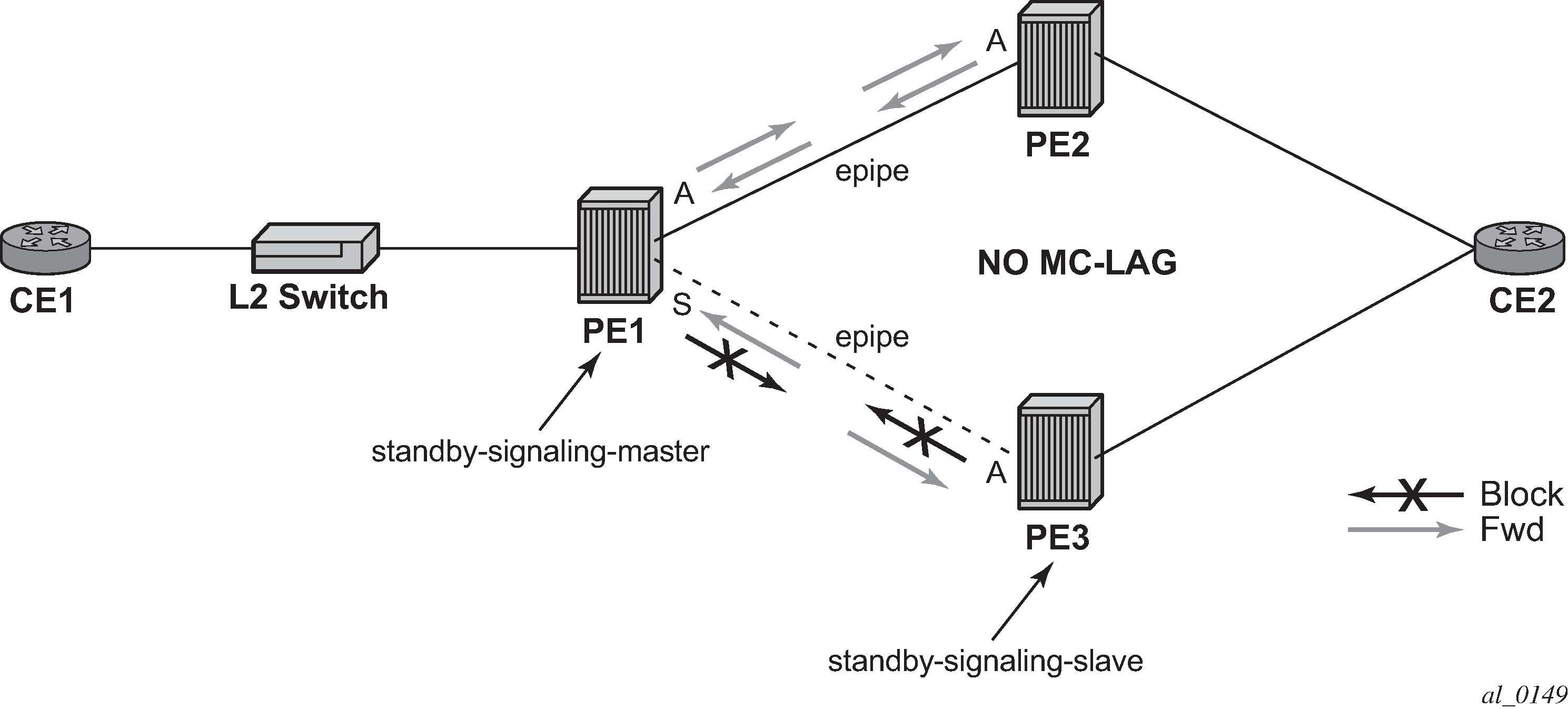This section describes a mechanism in which one end on a pseudowire (the "master") dictates the active PW selection, which is followed by the other end of the PW (the 'slave'). This mechanism and associated terminology is specified in RFC6870.
This section describes master-slave pseudowire redundancy. It adds the ability for the remote peer to react to the pseudowire standby status notification, even if only one spoke-SDP terminates on the VLL endpoint on the remote peer, by blocking the transmit (Tx) direction of a VLL spoke-SDP when the far-end PE signals standby. This solution enables the blocking of the Tx direction of a VLL spoke-SDP at both master and slave endpoints when standby is signaled by the master endpoint. This approach satisfies a majority of deployments where bidirectional blocking of the forwarding on a standby spoke-SDP is required.
Figure 1 shows the operation of master-slave pseudowire redundancy. In this scenario, an Epipe service is provided between CE1 and CE2. CE2 is dual-homed to PE2 and PE3; therefore, PE1 is dual-homed to PE2 and PE3 using Epipe spoke-SDPs. The objective of this feature is to ensure that only one pseudowire is used for forwarding in both directions by PE1, PE2, and PE3 in the absence of a native dual homing protocol between CE2 and PE2/PE3, such as MC-LAG. In normal operating conditions (the SAPs on PE2 and PE3 toward CE2 are both up and there are no defects on the ACs to CE2), PE2 and PE3 cannot choose which spoke-SDP to forward on, based on the status of the AC redundancy protocol.

Master-slave pseudowire redundancy adds the ability for the remote peer to react to the pseudowire standby status notification, even if only one spoke-SDP terminates on the VLL endpoint on the remote peer. When the CLI command standby-signaling-slave is enabled at the spoke-SDP or explicit endpoint level in PE2 and PE3, then any spoke-SDP for which the remote peer signals PW FWD Standby is blocked in the transmit direction.
This is achieved as follows. The standby-signaling-master state is activated on the VLL endpoint in PE1. In this case, a spoke-SDP is blocked in the transmit direction at this primary endpoint if it is either in operDown state, or it has lower precedence than the highest precedence spoke-SDP, or the specific peer PE signals one of the following pseudowire status bits:
Pseudowire not forwarding (0x01)
SAP (ingress) receive fault (0x02)
SAP (egress) transmit fault (0x04)
SDP binding (ingress) receive fault (0x08)
SDP binding (egress) transmit fault (0x10)
That the specified spoke-SDP has been blocked is signaled to the LDP peer through the pseudowire status bit (PW FWD Standby (0x20)). This prevents traffic being sent over this spoke-SDP by the remote peer, but only if that remote peer supports and reacts to pseudowire status notification. Previously, this applied only if the spoke-SDP terminates on an IES, VPRN, or VPLS. However, if standby-signaling-slave is enabled at the remote VLL endpoint, the Tx direction of the spoke-SDP is also blocked, according to the rules in Operation of Master-Slave Pseudowire Redundancy with Existing Scenarios.
Although master-slave operation provides bidirectional blocking of a standby spoke-SDP during steady-state conditions, it is possible that the Tx directions of more than one slave endpoint can be active for transient periods during a fail-over operation. This is because of the slave endpoints transitioning a spoke-SDP from standby to active receiving and, or processing a pseudowire preferential forwarding status message before those endpoints transitioning a spoke-SDP to standby. This transient condition is most likely when a forced switchover is performed, or the relative preferences of the spoke-SDPs are changed, or the active spoke-SDP is shutdown at the primary endpoint. During this period, loops of unknown traffic may be observed. Fail-overs because of common network faults that can occur during normal operation, or a failure of connectivity on the path of the spoke-SDP or the SAP, would not result in such loops in the data path.